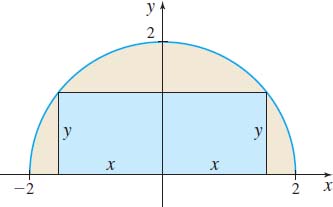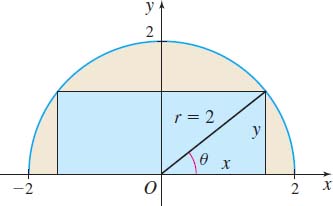EXAMPLE 5Maximizing Area
A rectangle is inscribed in a semicircle of radius 2. Find the dimensions of the rectangle that has the maximum area.
Solution We present two methods of solution: The first uses analytic geometry, the second uses trigonometry. To begin, we place the semicircle with its diameter along the x-axis and center at the origin. Then we inscribe a rectangle in the semicircle, as shown in Figure 59. The length of the inscribed rectangle is 2x and its height is y.
323
Analytic Geometry Method The area A of the inscribed rectangle is A=2xy and the equation of the semicircle is x2+y2=4, y≥0. We solve for y in x2+y2=4 and obtain y=√4−x2. Now we substitute this expression for y in the area formula for the rectangle to express A as a function of x alone. A=A(x)=2x√4−x20≤x≤2↑A=2xy;y=√4−x2
Then A′(x)=2[x(12) (4−x2)−1/2(−2x)+√4−x2]=2[−x2√4−x2+√4−x2]=2[−x2+(4−x2)√4−x2]=2[−2(x2−2)√4−x2]=−4(x2−2)√4−x2
The only critical number in the open interval (0,2) is √2, where A′(√2)=0. [−√2 and −2 are not in the domain of A, and 2 is not in the open interval (0,2).] The values of A at the endpoints 0 and 2 and at the critical number √2 are A(0)=0A(√2)=4A(2)=0
The maximum area of the inscribed rectangle is 4, and it corresponds to the rectangle whose length is 2x=2√2 and whose height is y=√2.
Trigonometric Method Using Figure 59, we draw the radius r=2 from O to the vertex of the rectangle and place the angle θ in the standard position, as shown in Figure 60. Then x=2cosθ and y=2sinθ, 0≤θ≤π2. The area A of the rectangle is A=2xy=2(2cosθ)(2sinθ)=8cosθsinθ=↑sin(2θ)=2sinθcosθ4sin(2θ)
Since the area A is a differentiable function of θ, we obtain the critical numbers by finding A′(θ) and solving the equation A′(θ)=0. A′(θ)=8cos(2θ)=0cos(2θ)=02θ=cos−10=π2θ=π4
We now find A′′(θ) and use the Second Derivative Test. A″
So at \theta =\dfrac{\pi }{4}, the area A is maximized and the maximum area of the inscribed rectangle is A\left( \dfrac{\pi }{4}\right) =4\sin \left( 2\cdot \frac{\pi }{4}\right) =4 \hbox{ square units}
The rectangle with the maximum area has \hbox{length}\, 2x=4\cos \dfrac{\pi }{4}=2 \sqrt{2}\,\, \hbox{and height}\,\, y=2\, \sin \dfrac{\pi }{4} =\sqrt{2}

